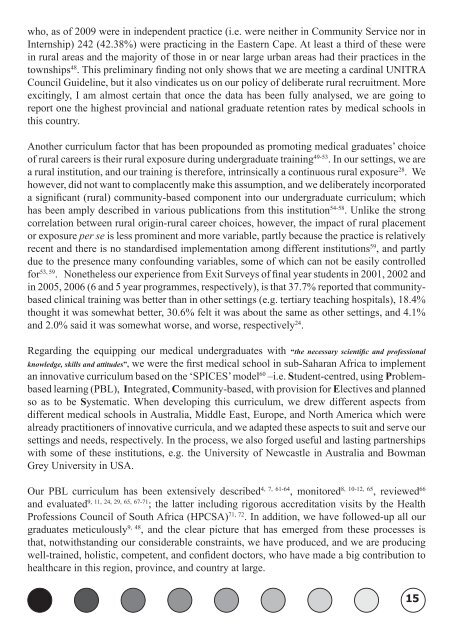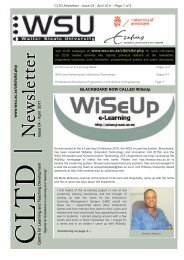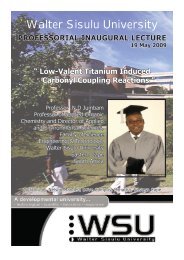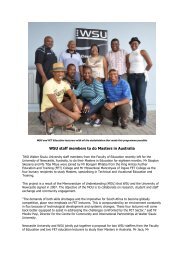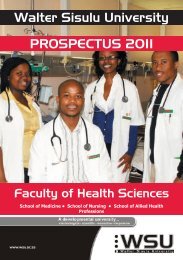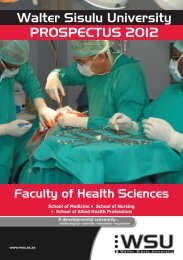25 years of training doctors at WSU: how - Walter Sisulu University
25 years of training doctors at WSU: how - Walter Sisulu University
25 years of training doctors at WSU: how - Walter Sisulu University
You also want an ePaper? Increase the reach of your titles
YUMPU automatically turns print PDFs into web optimized ePapers that Google loves.
who, as <strong>of</strong> 2009 were in independent practice (i.e. were neither in Community Service nor in<br />
Internship) 242 (42.38%) were practicing in the Eastern Cape. At least a third <strong>of</strong> these were<br />
in rural areas and the majority <strong>of</strong> those in or near large urban areas had their practices in the<br />
townships 48 . This preliminary finding not only s<strong>how</strong>s th<strong>at</strong> we are meeting a cardinal UNITRA<br />
Council Guideline, but it also vindic<strong>at</strong>es us on our policy <strong>of</strong> deliber<strong>at</strong>e rural recruitment. More<br />
excitingly, I am almost certain th<strong>at</strong> once the d<strong>at</strong>a has been fully analysed, we are going to<br />
report one the highest provincial and n<strong>at</strong>ional gradu<strong>at</strong>e retention r<strong>at</strong>es by medical schools in<br />
this country.<br />
Another curriculum factor th<strong>at</strong> has been propounded as promoting medical gradu<strong>at</strong>es’ choice<br />
<strong>of</strong> rural careers is their rural exposure during undergradu<strong>at</strong>e <strong>training</strong> 49-53 . In our settings, we are<br />
a rural institution, and our <strong>training</strong> is therefore, intrinsically a continuous rural exposure 28 . We<br />
<strong>how</strong>ever, did not want to complacently make this assumption, and we deliber<strong>at</strong>ely incorpor<strong>at</strong>ed<br />
a significant (rural) community-based component into our undergradu<strong>at</strong>e curriculum; which<br />
has been amply described in various public<strong>at</strong>ions from this institution 54-58 . Unlike the strong<br />
correl<strong>at</strong>ion between rural origin-rural career choices, <strong>how</strong>ever, the impact <strong>of</strong> rural placement<br />
or exposure per se is less prominent and more variable, partly because the practice is rel<strong>at</strong>ively<br />
recent and there is no standardised implement<strong>at</strong>ion among different institutions 59 , and partly<br />
due to the presence many confounding variables, some <strong>of</strong> which can not be easily controlled<br />
for 53, 59 . Nonetheless our experience from Exit Surveys <strong>of</strong> final year students in 2001, 2002 and<br />
in 2005, 2006 (6 and 5 year programmes, respectively), is th<strong>at</strong> 37.7% reported th<strong>at</strong> communitybased<br />
clinical <strong>training</strong> was better than in other settings (e.g. tertiary teaching hospitals), 18.4%<br />
thought it was somewh<strong>at</strong> better, 30.6% felt it was about the same as other settings, and 4.1%<br />
and 2.0% said it was somewh<strong>at</strong> worse, and worse, respectively 24 .<br />
Regarding the equipping our medical undergradu<strong>at</strong>es with “the necessary scientific and pr<strong>of</strong>essional<br />
knowledge, skills and <strong>at</strong>titudes”, we were the first medical school in sub-Saharan Africa to implement<br />
an innov<strong>at</strong>ive curriculum based on the ‘SPICES’ model 60 –i.e. Student-centred, using Problembased<br />
learning (PBL), Integr<strong>at</strong>ed, Community-based, with provision for Electives and planned<br />
so as to be System<strong>at</strong>ic. When developing this curriculum, we drew different aspects from<br />
different medical schools in Australia, Middle East, Europe, and North America which were<br />
already practitioners <strong>of</strong> innov<strong>at</strong>ive curricula, and we adapted these aspects to suit and serve our<br />
settings and needs, respectively. In the process, we also forged useful and lasting partnerships<br />
with some <strong>of</strong> these institutions, e.g. the <strong>University</strong> <strong>of</strong> Newcastle in Australia and Bowman<br />
Grey <strong>University</strong> in USA.<br />
Our PBL curriculum has been extensively described 4, 7, 61-64 , monitored 8, 10-12, 65 , reviewed 66<br />
and evalu<strong>at</strong>ed 9, 11, 24, 29, 65, 67-71 ; the l<strong>at</strong>ter including rigorous accredit<strong>at</strong>ion visits by the Health<br />
Pr<strong>of</strong>essions Council <strong>of</strong> South Africa (HPCSA) 71, 72 . In addition, we have followed-up all our<br />
gradu<strong>at</strong>es meticulously 9, 48 , and the clear picture th<strong>at</strong> has emerged from these processes is<br />
th<strong>at</strong>, notwithstanding our considerable constraints, we have produced, and we are producing<br />
well-trained, holistic, competent, and confident <strong>doctors</strong>, who have made a big contribution to<br />
healthcare in this region, province, and country <strong>at</strong> large.<br />
15


